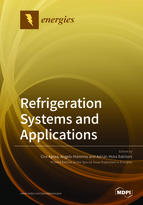Refrigeration Systems and Applications 2019
A special issue of Energies (ISSN 1996-1073). This special issue belongs to the section "J: Thermal Management".
Deadline for manuscript submissions: closed (30 September 2019) | Viewed by 44262
Special Issue Editors
Interests: thermal engineering; heat exchangers; heat transfer; vapour compression refrigeration systems; autocascade systems; magnetic refrigeration; elastocaloric refrigeration; electrocaloric refrigeration
Special Issues, Collections and Topics in MDPI journals
Interests: thermal engineering; refrigeration; magnetic refrigeration; elastocaloric refrigeration; electrocaloric refrigeration; artificial neural network in the field of refrigeration; natural refrgierants; transcritical refrigeration systems
Special Issues, Collections and Topics in MDPI journals
Interests: refrigeration; heat pumps; low global warming potential refrigerants; organic Rankine cycle; energy conversion; phase change materials; energy efficiency
Special Issues, Collections and Topics in MDPI journals
Special Issue Information
Dear Colleagues,
We are pleased to invite you to submit your high-level scientific papers to a Special Issue of Energies (IF 2.676) entitled “Refrigeration Systems and Applications”.
Refrigeration applications, mostly based on vapour compression systems, represent a significant contribution to global climate change. While refrigeration is necessary for the appropriate development of humanity, it is predicted that an increase in the number of refrigeration applications will worsen the issue of climate change. Hence, energy efficient systems with a lower contribution to global warming are required. In the last years, the research and development of new working fluid, technologies, and methodologies have provided an opportunity for the transition from vapour compression systems based on fluorine fluids to more sustainable solutions.
For instance, the potential advantages and drawbacks of hydrofluoroolefins are being investigated, and mixtures with hydrofluorocarbons are being developed to find trade-off solutions. Furthtermore, the applications of hydrocarbons are being extended to installations that require a lower refrigerant charge. Lower flammability refrigerants require new flammability and risk analysis studies to determine their possible hazard. Heat and mass transfer phenomena studies are being carried out for new pure and mixture refrigerants. Ejectors are being studied to increase energy performance in particular applications. Alternative technologies based on renewable energy or solid states, such as solar cooling or magnetic refrigeration, are being developed and integrated into new processes. The integration of phase change materials and slurries is becoming a new option. Finally, nanoparticles and nanofluids have opened an entirely new world of possibilities.
The literature available on these topics is still in an early stage, and these working fluids, technologies, and methodologies cannot be considered as mature. However, this creates significant potential for improving the energy efficiency as well as the operation and capacity range of these new approaches. The Special Issue “Refrigeration Systems and Applications” aims to encourage researchers to solve the concerns associated with these topics and to further the transition to more sustainable technologies and methodologies of tomorrow through theoretical, experimental, and review research on the different applications of refrigeration and associated topics.
We look forward to your submissions, which will be peer-reviewed by international colleagues with broad expertise in this specific topic.
Prof. Dr. Ciro Aprea
Prof. Dr. Angelo Maiorino
Dr. Adrián Mota Babiloni
Guest Editors
Manuscript Submission Information
Manuscripts should be submitted online at www.mdpi.com by registering and logging in to this website. Once you are registered, click here to go to the submission form. Manuscripts can be submitted until the deadline. All submissions that pass pre-check are peer-reviewed. Accepted papers will be published continuously in the journal (as soon as accepted) and will be listed together on the special issue website. Research articles, review articles as well as short communications are invited. For planned papers, a title and short abstract (about 100 words) can be sent to the Editorial Office for announcement on this website.
Submitted manuscripts should not have been published previously, nor be under consideration for publication elsewhere (except conference proceedings papers). All manuscripts are thoroughly refereed through a single-blind peer-review process. A guide for authors and other relevant information for submission of manuscripts is available on the Instructions for Authors page. Energies is an international peer-reviewed open access semimonthly journal published by MDPI.
Please visit the Instructions for Authors page before submitting a manuscript. The Article Processing Charge (APC) for publication in this open access journal is 2600 CHF (Swiss Francs). Submitted papers should be well formatted and use good English. Authors may use MDPI's English editing service prior to publication or during author revisions.
Keywords
- new low global warming potential refrigerants
- natural refrigerants
- air source and ground source heat pumps
- energy efficiency optimisation of refrigeration systems
- advanced refrigeration architectures
- solid state refrigeration technologies (magnetic, elastocaloric, and electrocaloric refrigeration)
- refrigeration technologies based on renewable energies (solar cooling)
- heat and mass transfer in refrigeration systems
- phase change materials and slurries
- determination of thermophysical and transport properties
- nanorefrigerants and nanolubricants
- control methods in refrigeration systems








